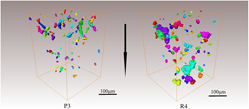Article contents
3-D characterization of incipient spallation response in cylindrical copper under sweeping detonation
Published online by Cambridge University Press: 08 March 2017
Abstract

The effect of peak shock stress on the incipient spallation damage in a cylindrical sample under sweeping detonation is presented. The free surface velocity curve was measured by photon Doppler velocimetry and the quantitative investigation of voids in a spalled sample was performed using X-ray computer tomography. The results revealed that the maximum volume and the mean volume of voids in the spalled sample increased with increasing shock stress. The sphericity of voids decreases with the increasing of shock stress. The rod voids were the result of the independent growth of voids along the grain boundaries in samples with lower shock stress, while the rod shaped voids in sample with higher shock stress were formed due to coalesce. The rod voids can be found in a cylindrical sample, while the voids in plate samples were in the shape of spheres or ellipsoids, and the difference of stress state induced by the curvature in the geometry of samples may be the main reason.
- Type
- Articles
- Information
- Copyright
- Copyright © Materials Research Society 2017
Footnotes
Contributing Editor: Jürgen Eckert
References
REFERENCES
- 9
- Cited by



